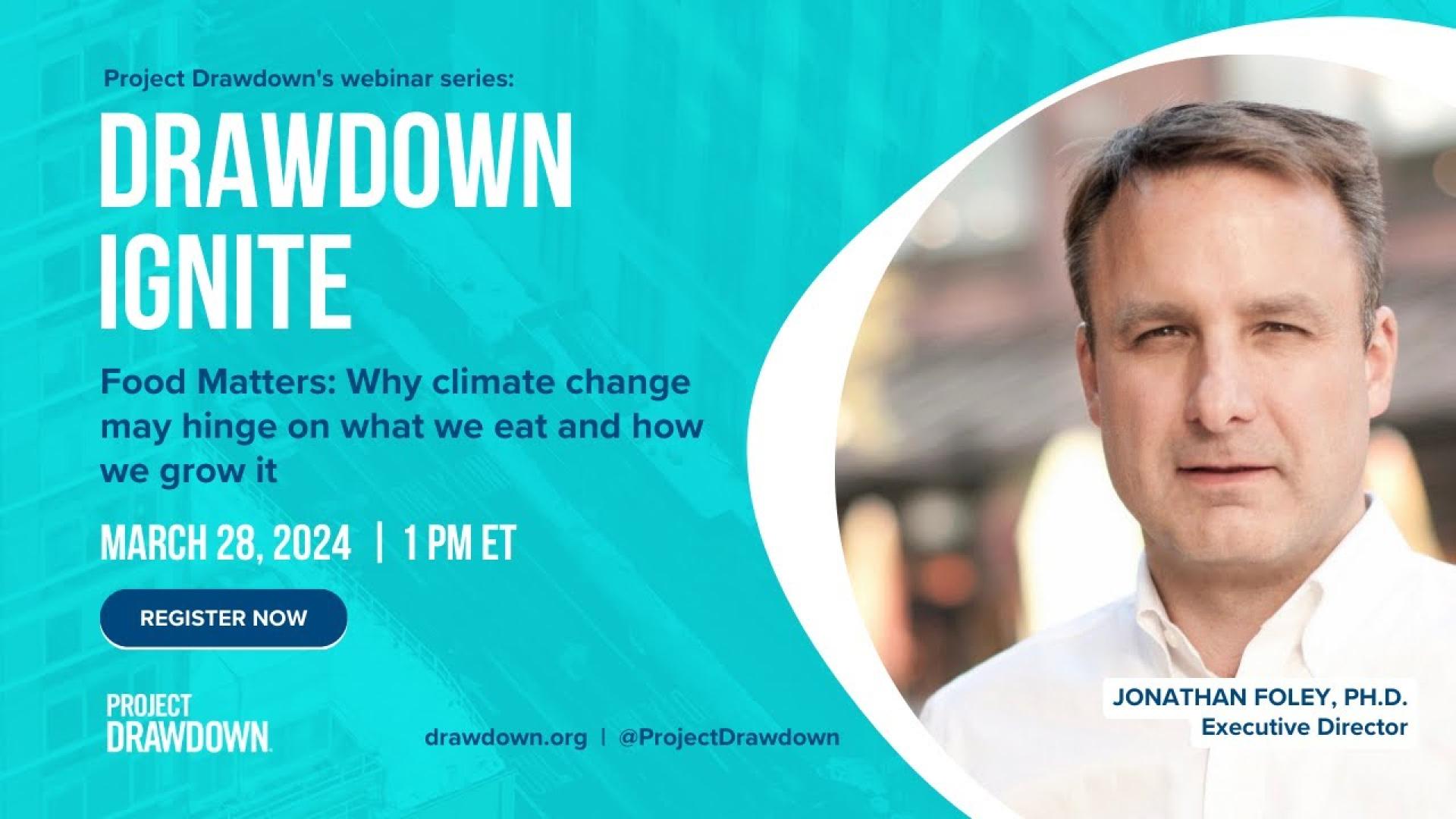Project Drawdown updates and expands its climate solutions set

Undersea kelp forests like this one off the coast of California are among the most productive ecosystems on Earth. Protecting and restoring these habitats enhances carbon sequestration in the deep sea.
Credit: iStock.com/fdastudilloFive years ago Project Drawdown published a collection of “drawdown solutions,” technologies and practices that, if ambitiously implemented together, can achieve drawdown—the point in the future when levels of greenhouse gases in the atmosphere stop climbing and start to steadily decline, thereby stopping catastrophic climate change. A newly released update of this landmark analysis adds 11 new solutions and confirms with even more clarity and conviction that humanity has the solutions needed to reach drawdown quickly, safely, efficiently, and equitably.
The update lays the groundwork for Project Drawdown’s next major effort: developing and helping to activate strategies for implementing climate solutions that also benefit human well-being, biodiversity, and more. Businesses, funders, organizations, and individuals are encouraged to use the updated solutions set as a resource for making wise choices as to how to direct their climate solutions efforts.
Currently Available, Readily Scalable
To assess the possibilities for putting the brakes on climate change, experts in fields from oceanography to mechanical engineering and artificial intelligence modeled the greenhouse gas and economic impacts of adopting currently available and readily scalable technologies and practices under two levels of adoption that roughly correspond to limiting warming to 2°C and 1.5°C, respectively. They updated the existing solutions by incorporating new population growth models and new data for 16 of the solutions (all 13 Transportation sector solutions, Family Planning and Education, Plant-Rich Diets, and Reduced Food Waste). They also added 11 new solutions assessing strategies for reducing greenhouse gases related to ocean resources, food production, methane management, and materials manufacturing and use.
All solutions are based on an extensive analysis of the scientific literature and sophisticated modeling and share six key traits that set them apart from other sets of climate mitigation strategies. They 1) are currently available, 2) are growing in scale, 3) are financially viable, 4) are able to reduce greenhouse gas concentrations in Earth’s atmosphere, 5) have a net positive impact, and 6) are quantifiable under different scenarios.
New Solutions
The 11 new solutions are:
Seaweed Farming – Seaweed farming is one of the most sustainable types of aquaculture. Expanding seaweed farming enhances carbon sequestration and boosts production of biomass that can be used for biofuel, bioplastic, livestock feed, and human consumption.
Macroalgae Protection and Restoration – Macroalgae forests are among the most productive ecosystems on Earth. Protecting and restoring those habitats, enhances carbon sequestration in the deep sea.
Improved Fisheries – Improved fisheries involves reforming and improving the management of wild-capture fisheries to reduce excess effort, overcapitalization, and overfishing. This can reduce fuel usage and rebuild fish populations.
Improved Aquaculture – Aquaculture is one of the fastest-growing animal food sectors. Because some aquaculture systems are highly energy intensive, ensuring that part of the on-site energy consumption is based on renewable resources would reduce greenhouse gas emissions.
Seafloor Protection – Vast amounts of carbon stored in seafloor sediments risk release by bottom-trawling fishing. Bottom-trawling bans and establishment of Marine Protected Areas can protect this important carbon sink.
Improved Cattle Feed – Optimizing cattle feeding strategies can lower the methane emissions produced within the ruminant digestive system. Nutrient-enriched diets of high-quality forages, additives, and supplements aim to improve animal health and productivity.
Improved Manure Management – Livestock manure produces methane, a potent greenhouse gas. Advanced technologies and practices for managing manure can reduce the adverse climate impact of animal agriculture.
Methane Leak Management – Methane, a potent greenhouse gas, is emitted during the production and transport of oil and natural gas. Managing methane emissions can reduce greenhouse gases in the atmosphere.
Recycled Metals – Metals are extracted from nonrenewable ores. Recycled metals capitalize on already extracted materials—making it possible to produce goods more efficiently, reduce the need to extract new resources, and cut down on energy and water use.
Recycled Plastics – Recycling plastics requires less energy than producing new materials, saves landfill space, reduces environmental pollution, and decreases demand for fossil-fuel-based raw materials.
Reduced Plastics – Plastic production has grown tremendously over the past century, mainly for short-term use. Reducing the amount of plastic used in nondurable goods can significantly reduce both greenhouse gas emissions and plastic waste.
Highlights
Among the highlights of the update:
- An initial investment of US$15.6 trillion (Scenario 1) would avoid or sequester more than 1,000 gigatons of carbon dioxide equivalent greenhouse gases between 2020 and 2050 and save nearly US$98 trillion in total operating costs over the lifetime of the solution.
- Bumping the investment up to US$23.6 trillion (Scenario 2) would avoid or sequester more than 1,600 gigatons of gases and save more than US$140 trillion in lifetime costs.
- Under Scenario 1, which aligns roughly with IPCC’s 2°C target, Food, Agriculture, and Land Use sector solutions have the greatest impact on greenhouse gases. Under Scenario 2, which aligns roughly with IPCC’s 1.5°C target, the Electricity sector jumps to the top for atmospheric greenhouse gas reductions.
- Updating the Family Planning and Education solution created changes across all solutions, since it replaces the previous projection of 2050 population with a lower number, creating a lower demand for the other solutions. Notably, nearly half (46 percent) of the impact of the lower population projection is attributable to more developed countries because of the higher per-capita contribution. The impact of education is hard to quantify because it affects many things besides reproductive choices (e.g., ability to implement other solutions).
- In the Electricity and Buildings sectors, lower functional demand due to lower population projections means fewer emissions in the baseline (business as usual) scenario, which means it’s easier to achieve climate goals.
- Changes in the Transportation sector are mainly due to newer and better data. We’re seeing more potential for electrification, especially in freight and public transit. Small changes in adoption can result in big impacts due to the large number of passenger miles globally.
- There are lots of opportunities for improvement in the Industry sector. Small increases in adoption can make a big difference because of large volumes of materials. Shifting to low-emissions-intensity materials is the source of most of the gain. Some industries (e.g., steel) can show only modest gains in energy efficiency; the biggest opportunities are for switching to new materials instead.
- New data on emissions for 88 commodities made a big difference in the Food, Agriculture, and Land Use sector. Plant-Rich Diets and Reduced Food Waste are now at the top of the potential impact list in Scenario 1 and are right after Onshore Wind Turbines and Utility-Scale Solar Photovoltaics in Scenario 2. Even though population estimates declined, new diet and emissions factors more than made up for the savings. Potential reductions are likely even higher than what we’re seeing here.
- Protecting intact coastal wetlands such as mangroves is the most effective solution in the Coastal and Ocean Sinks sector. Seaweed has high sequestration potential. Protection and restoration have many co-benefits. Fisheries improvements that increase fish stocks mean more fish die in the ocean and so more biomass is sequestered in the deep ocean.
- Methane reduction is important because it can produce quick, measurable results critical for reaching net zero by 2050. Methane reduction provides big opportunities for greenhouse gas reductions at a relatively low cost. Eliminating leaks from the oil and gas production sector is cost-effective and simple. Landfill methane capture is a clear win.
In sum, we confirmed that the practices and technologies implemented to reduce greenhouse gas emissions will more than pay for themselves in lifetime savings. In addition, many of the solutions have bonus benefits for reducing poverty, increasing equity, and protecting endangered animals and ecosystems. So solving the climate crisis is both a life-saving and money-saving move for future generations.
Research Team
Fellows and staff who played key roles in the updates include Chad Frischmann, Mamta Mehra, Mahmoud Abdelhamid, Zak Accuardi, Mohammad Ahmadi Achachlouei, Raihan Ahmed, Carolyn Alkire, Ryan F. Allard, Jimena Alvarez, Chirjiv Anand, Jay H. Arehart, Senorpe Asem-Hiablie, Jay Barlow, Kevin Bayuk, Renilde Becqué, Erika Boeing, Jvani Cabiness, Johnnie Chamberlin, Delton Chen, Wu Chen, Kristina Colbert, Leonardo Covis, Susan Miller Davis, Tala Daya, Priyanka DeSouza, Barbara Rodriguez Droguett, Stefan Gary, Jai Kumar Gaurav, Anna Goldstein, Miranda R. Gorman, João Pedro Gouveia, Alisha Graves, Martina Grecequet, Karan Gupta, Zhen Han, Zeke Hausfather, Yuill Herbert, Amanda Hong, Ariel Horowitz, Ryan Hottle, Troy Hottle, Sarah Eichler, David Jaber, Marzieh Jafary, Mel De Jager, Dattakiran Jagu, Emilia Jankowska, Heather Jones, Daniel Kane, Kapilnarula, Sumedha Malaviya, Urmila Maldvakar, Ashok Mangotra, Alison Mason, Mihir Mathur, David Mead, Aven Satre-Meloy, Phil Metz, Ruth Metzel, Alex Michelko, Ida Midzic, Karthik Mukkavilli, Sarah Myhre, Amrita Namasivayam, Kapil Narula, Rob Newell, Demetrios Papaioannou, Michelle Pedraza, Robin Pelc, Noorie Rajvanshi, George Randolph, Abby Rubinson, Adrien Salazar, Aven Satre-Meloy, Jon Schroeder, Celina Scott-Buechler, Christine Shearer, David Siap, Kelly Siman, Leena Tähkämö, Ernesto Valero Thomas, Eric Toensmeier, Shahaboddin Sean H. Toroghi, Melanie Valencia, Andrew Wade, Marilyn Waite, Ariani Wartenberg, Charlotte Wheeler, Christopher W. Wright, Liang Yang, Daphne Yin, Abdulmutalib Yussuff, and Kenneth Zame.
Other Resources
Two of the studies behind the new results have been released in peer-reviewed journals. Emilia Jankowska, Robin Pelc, Jimena Alvarez, Mamta Mehra, and Chad Frischmann published a report on the six new ocean-related solutions in PNAS in June. Miranda Gorman, David Dzombak, and Chad Frischmann published an article on the metals recycling solution in the September 2022 Resources, Conservation and Recycling.
In addition to releasing the new solutions and updating existing ones, Project Drawdown put its research models—which help quantify the potential size and economics of different climate solutions—into the public domain. This process is still in the early stages, and many pieces of software are still under development. Interested individuals can check out the ongoing work on Github, where Python and Excel versions of the models are being worked on, along with user interfaces, data management tools, and other software tools.
Press Contacts
If you are a journalist and would like to republish Project Drawdown content, please contact press@drawdown.org.



